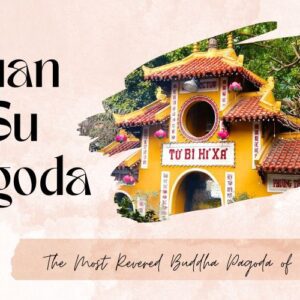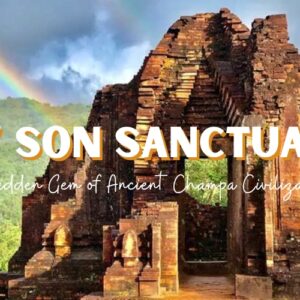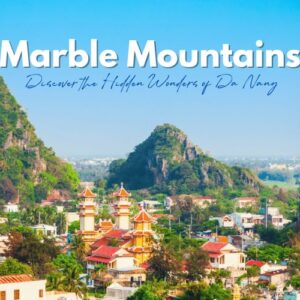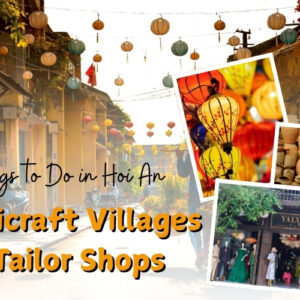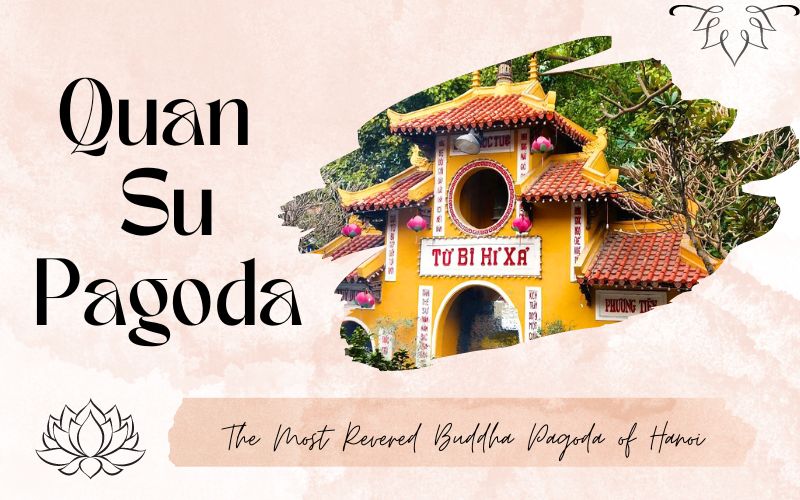
In the heart of Hanoi’s capital, the cultural and spiritual essence of the nation is expressed through hundreds of sacred works. Each temple, such as Tran Quoc Pagoda or One Pillar Pagoda, is steeped in history and unique architecture, representing the cultural and spiritual richness of this land. Quan Su Pagoda is one of the familiar ancient temples and a major pilgrimage for many Buddhists and tourists. Therefore, where is Quan Su Pagoda and the opening hours of Quan Su Pagoda are the questions of many tourists who want to visit.
With a thickness of hundreds of years, Quan Su Pagoda is a place to preserve many cultural and spiritual values of the country. This place is one of the temples in Hanoi that attracts many Buddhists and tourists traveling to Vietnam on a pilgrimage. Let’s stop at Quan Su Pagoda to feel peace and tranquility.
Essential Information for Tourists
Location of Quan Su Pagoda
Quan Su Pagoda is located at No.73 Quan Su Street, Tran Hung Dao Ward, Hoan Kiem District, Hanoi. The temple is only about 1km from Hoan Kiem Lake, so it is very convenient for tourists to visit.
Opening hours and Entrance fee
Operating hours: Visitors are warmly welcomed at Quan Su Pagoda every day, with operating hours extending from 6 am until 7 pm.
Admission fees: Free.
Regulations of Quan Su Pagoda
- Wear standard, polite, non-offensive clothing.
- Wear shoes and sandals with low soles for easy walking.
- Use vegetarian and pure foods such as flower incense, ripe fresh fruit, betel nut, sticky rice with tea, or products to offer incense to the Buddha.
- Talk, communicate softly, and avoid making noise.
- Avoid carrying too many junk items when entering the Tam Bao Dien area.
The History of Quan Su Pagoda
According to the remaining ancient documents, the pagoda was built around the 14th century, under King Tran Du Tong. At that time, the envoys from the southern countries (Chiem Thanh, Van Tuong, and Ai Lao) to the Thang Long Citadel to pay tribute were all devoted to Buddhism. The court built a building to receive the ambassadors and a temple named Quan Su (the residence of the emissary) right at the park so that they could worship during their stay there. Until the time of Le Trung Hung’s dynasty, he still kept that routine. It is also recorded that this temple was built during the reign of King Le The Tong, around the 15th century.

Quan Su Pagoda
In the reign of King Gia Long, Thang Long became the North Citadel and the Nguyen court moved to Phu Xuan to establish a new capital, Quan Su Pagoda became the place of worship for the soldiers of the Hau Quan post. When the soldiers withdrew from the fort, the temple was returned to the villagers. The new abbot of the temple for embellishing built more corridors, painted statues, casting bells. In 1934, this place became the central headquarters of the Tonkin Buddhist Association, now the Vietnam Buddhist Sangha. In 1942, Venerable To Vinh Nghiem reviewed the design of architects Nguyen Ngoc Ngoan and Nguyen Xuan Tung to restore the temple according to the architecture we see today.
The Main Highlight of Quan Su Pagoda
The architecture of Quan Su Pagoda
The architecture of this ancient temple converges the architectural quintessence of the great temples in the North of our country. The pagoda’s campus is designed according to the layout of “National Congregation and Foreign Affairs” (the internal architecture is in the shape of the letter Cong, and the outside is in the shape of the letter Quoc). Quan Su Pagoda is a unique architectural complex with a harmonious combination of a spacious campus, rooftops, and a bell tower. After many restorations, the temple includes the following items: Tam Quan, the main building, library, guest house, and lecture hall.
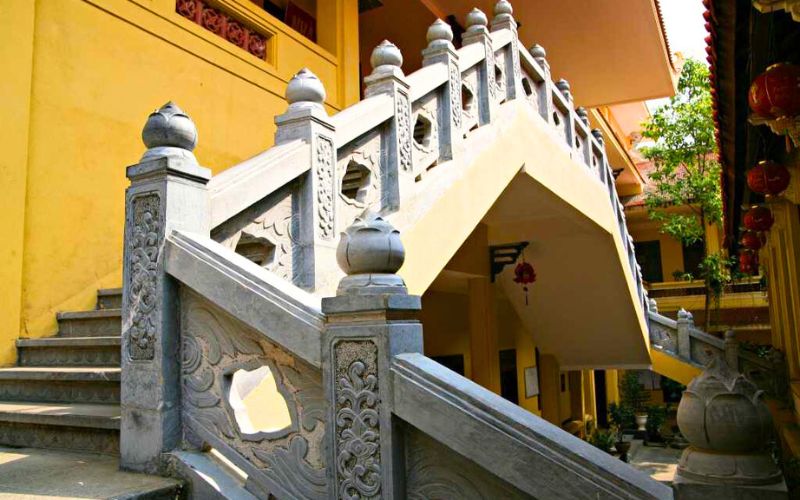
Open-air stairs on the temple grounds
Tam Quan has 3 roof floors, and in the middle is the bell tower. Behind the gate is a brickyard leading to 11 to bring visitors into the main hall. The main hall is built in a square shape, consisting of 2 floors, surrounded by corridors. Tam Bao building is located on the 2nd floor, the lower floor has a soundproofing function. The main hall is connected to the back street building via an open-air staircase on the middle floor. The two sides and the back of the temple yard are the libraries, the guest house, the hall, and the lecture hall.
Place of worship
In the main hall, the Buddha Hall is decorated dignified. The large statues painted in splendid gilding are arranged in each level from high to low, which is the statue of three Buddhas Tam – Amitabha Buddha in the middle, two sides Bodhisattva Avalokitesvara and Dai The Chi – Buddha statue in the middle, two sides of Venerable Ananda and Ca Diep – Cuu Long Court is placed between Bodhisattva Avalokitesvara and Ksitigarbha.
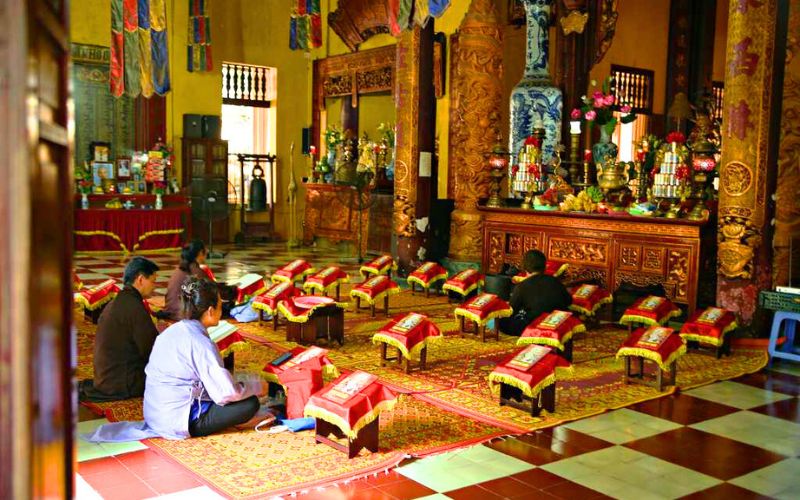
Quan Su Pagoda is a Place of Worship, so be Respectful of the Religious Sentiments
To the right of the main hall is an altar to worship Ly Quoc Su (Zen Master Nguyen Minh Khong) and 2 attendants. On the left side is to worship Duc Ong, Quan Binh, and Chau Suong. On the side of Dai Hung Bao Dien is the ancestral church worshiping the Great Patriarch of Vietnamese Buddhism. Quan Su Pagoda does not worship Mother and Tam – Tu Phu, which is not Buddhist like many other temples.
Library stores important Buddhist documents and bibliographies
On the temple grounds, there are halls, lecture halls, and Buddhist libraries. The pagoda is home to the Office of the Vietnam Buddhist Studies Sub-Institute and the Office of the Asian Buddhist Organization for Peace in Vietnam. This is also the place where the Board of Directors office, the Proofing Council office, and the international living room are located.
Currently, the monks in the Vietnam Buddhist Sangha, the Central Executive Council of the Vietnam Buddhist Sangha, and the monks, nuns, monks, and nuns of the Central Office of the Vietnam Buddhist Sangha are all working at the temple. Quan Su Pagoda is a place to store a lot of Buddhist documents and books and is one of the largest centers of Buddhist research, teaching, and propagation in Vietnam.
Best Places to Visit near Quan Su Pagoda
Hoan Kiem Lake
Hoan Kiem Lake, situated in the center of Hanoi, is a captivating destination known for its scenic beauty and tranquil ambiance. It provides the perfect setting for a leisurely stroll, allowing you to immerse yourself in the serenity of the surroundings. A visit to Hoan Kiem Lake wouldn’t be complete without exploring Ngoc Son Temple, nestled on a picturesque island within the lake. This ancient temple offers a glimpse into Vietnam’s rich cultural heritage. Additionally, the lakeside benches beckon visitors to unwind and bask in the peaceful atmosphere, providing an ideal spot for relaxation and contemplation.
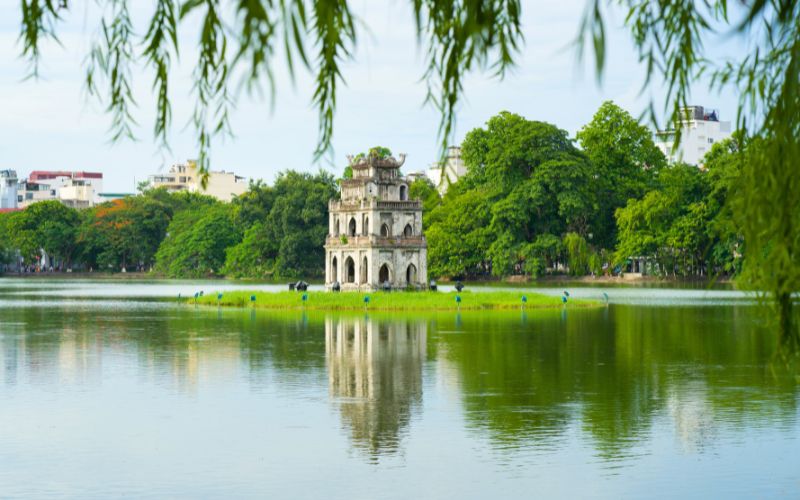
Hoan Kiem Lake
Hanoi Old Quarter
In close proximity to Quan Su Pagoda, you’ll discover Hanoi’s Old Quarter, a lively and dynamic neighborhood renowned for its narrow alleyways, captivating colonial architecture, and traditional establishments. As you navigate the charming streets of the Old Quarter, you’ll find yourself surrounded by a plethora of traditional shops and markets. Furthermore, the Old Quarter is renowned for its delectable street food scene. Throughout the area, you’ll encounter countless food stalls and small restaurants serving up a myriad of enticing dishes, such as pho, banh mi, bun cha, banh xeo, etc.
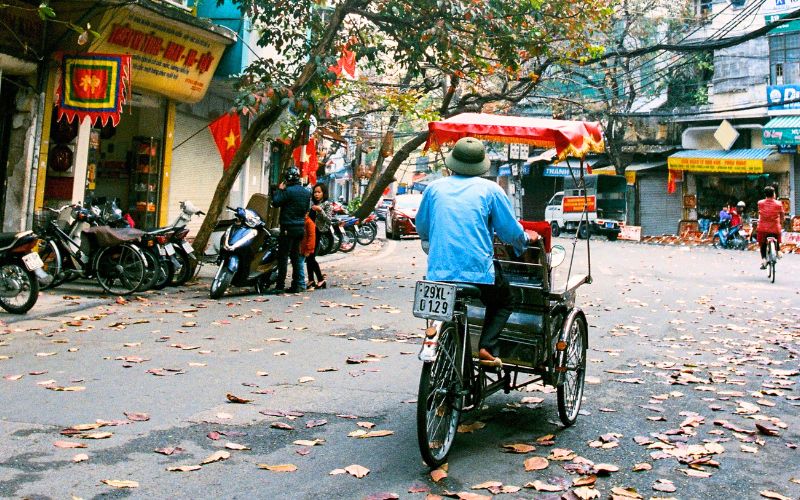
Hanoi Old Quarter
Immersing yourself in the Old Quarter’s bustling streets not only allows you to experience the city’s vibrant energy but also provides a glimpse into its fascinating history. The colonial architecture, with its distinct French influence, adds a unique charm to the area.
St. Joseph’s Cathedral
St. Joseph’s Cathedral, located near Quan Su Pagoda, is a remarkable Roman Catholic Church that stands as an architectural gem. Its neo-Gothic design, adorned with intricate details and towering spires, draws the attention of visitors from near and far. The cathedral’s facade features pointed arches, flying buttresses, and intricate stone carvings, all characteristics of the Gothic architectural style. Its imposing presence and grandeur make it a prominent landmark in the city.
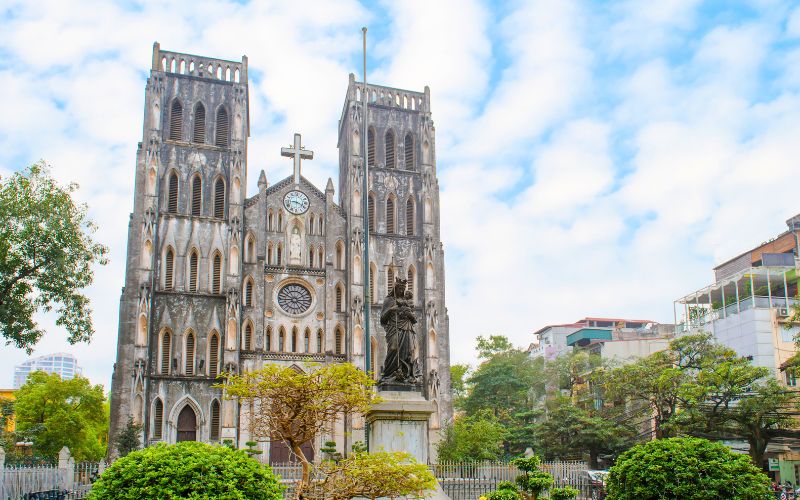
St. Joseph’s Cathedral
Step inside St. Joseph’s Cathedral, and you’ll be greeted by a tranquil atmosphere and a sense of serenity. The interior is adorned with stunning stained-glass windows that depict biblical scenes and saints, allowing vibrant colors to filter through and create a mesmerizing play of light within the space.
Hoa Lo Prison Museum
The Hanoi Hilton, officially known as Hoa Lo Prison Museum, provides a unique insight into the history of the Vietnam War. The museum highlights the conditions faced by both Vietnamese revolutionaries and American prisoners of war at different stages throughout the war. The museum displays artifacts, photographs, and exhibits that depict the experiences of the prisoners, illustrating the harsh living conditions and the resilience of those held captive.
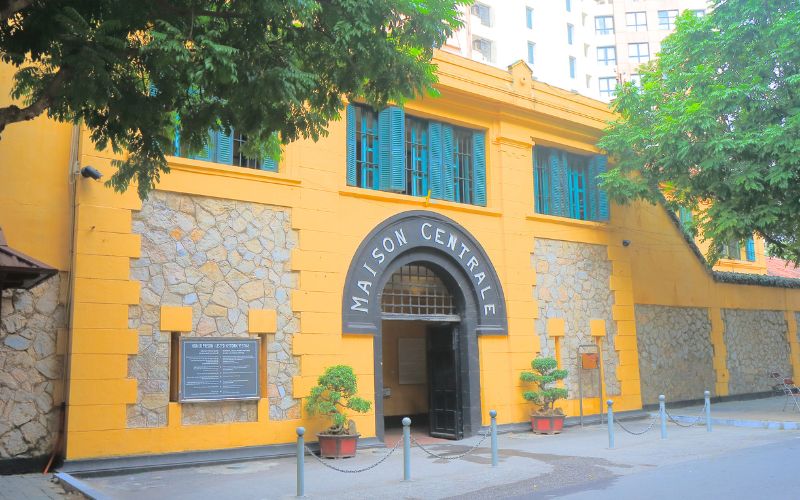
Hoa Lo Prison Museum
In addition to its focus on the American prisoners, the museum also delves into the history of Vietnamese revolutionaries who were imprisoned there during the colonial period. Visitors can explore the cells, see the remnants of the original prison, and gain a deeper understanding of the historical context and significance of the site.
Thang Long Water Puppet Theater
Located near Hoan Kiem Lake, Thang Long Water Puppet Theater provides an exceptional opportunity to immerse oneself in the richness of local culture. At this enchanting theater, you will witness the artistry of water puppetry, a unique form of Vietnamese entertainment that dates back centuries. The performances take place on a shallow pool of water, with intricately crafted puppets gracefully dancing and gliding across the surface. Accompanied by a live traditional orchestra, the puppeteers skillfully manipulate the puppets to bring traditional folklore, legends, and tales to life.
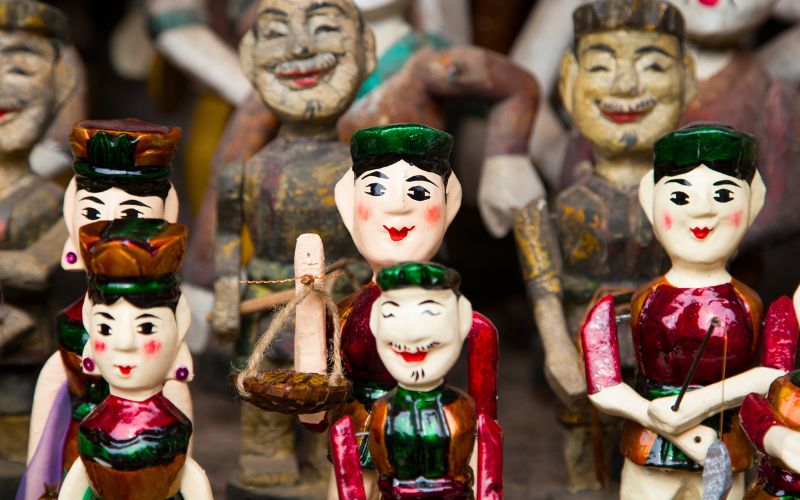
Thang Long Water Puppet Theater
Getting to Quan Su Pagoda
Taxi/Grab/Private Car
Traveling by taxi or utilizing ride-hailing services such as Grab or other car services is a convenient and straightforward method to reach Quan Su Pagoda. Just provide the driver with the address “73 Quan Su Street,” and they will be able to transport you directly to the temple.
You can also consider the possibility of renting a car with a private driver as an alternative. This option provides the convenience of having a dedicated driver who is well-versed in navigating Hanoi. Many of these drivers are fluent in English and can offer valuable insights into the city, including its historical landmarks, delightful cuisine, popular entertainment venues, and more. If you would like more information about this service, please feel free to contact us.
Public Bus
Hanoi boasts a comprehensive public bus network, offering various routes that pass near Quan Su Pagoda. To reach the pagoda, identify the nearest bus stop to your location and board a bus heading in the direction of the temple. It is advisable to utilize a local map or a public transportation app to help you plan your route effectively. If using the bus, routes 01, 32, and 40 have stops near Quan Su Pagoda. You can choose the above bus routes to reach the temple most conveniently.
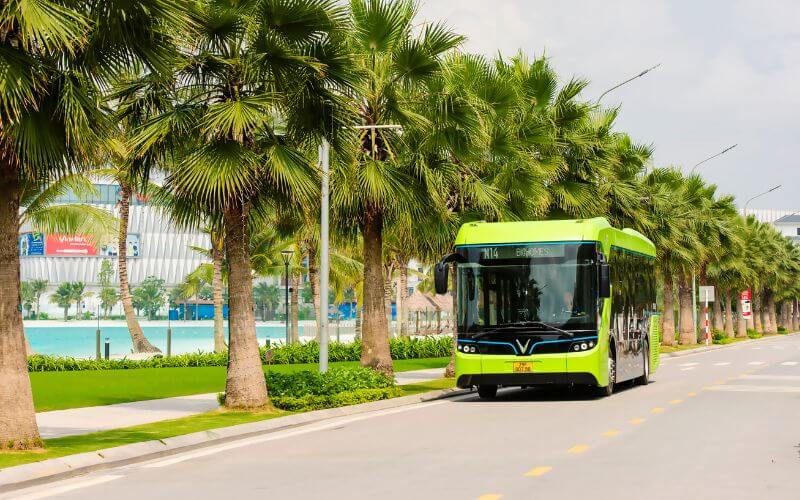
Hanoi Bus
Walking
If you find yourself in the city center or nearby areas, walking to Quan Su Pagoda can be a delightful option to consider. Hanoi is a compact city, and if the distance is not too far, strolling on foot can provide an enjoyable opportunity to immerse yourself in the city streets, soak up the atmosphere, and appreciate the surrounding sights.
Cyclo/Rickshaw
Experience the traditional and distinctive mode of transportation in Hanoi by opting for a cyclo or rickshaw ride. Hire a skilled cyclo or rickshaw driver who can transport you to Quan Su Pagoda, offering a delightful and leisurely journey with scenic views along the way.
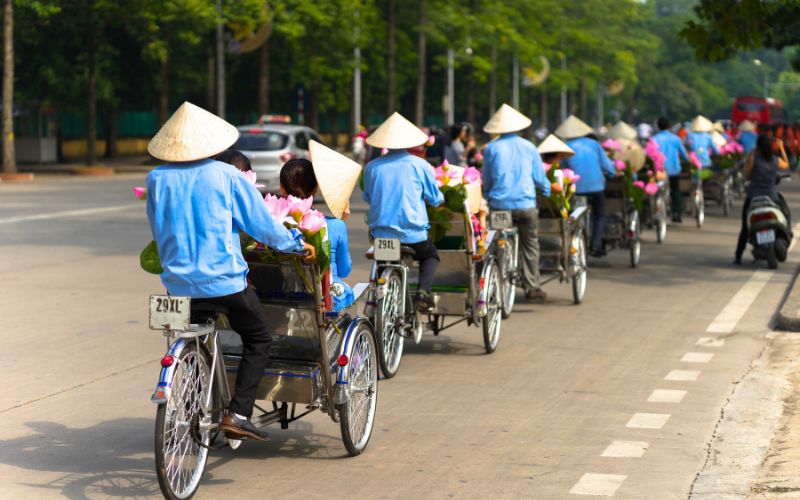
Cyclo in Hanoi
Regardless of whether you are a resident of the capital or a tourist, if you come to Hanoi, you should definitely not miss the opportunity to visit Quan Su Pagoda. Come here to fully experience the peace and sacredness of an ancient temple with hundreds of years of history. Quan Su Pagoda will definitely give you a deep sense of the spirituality and value of Buddhist culture in accordance with the currents of Vietnam. If you’re planning to travel to Hanoi in the near future, please don’t hesitate to contact us. We are here to assist you with any inquiries, provide information, or offer recommendations to make your trip to Hanoi a memorable experience.
